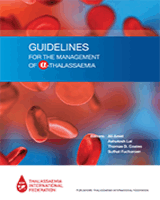NCBI Bookshelf. A service of the National Library of Medicine, National Institutes of Health.
Amid A, Lal A, Coates TD, et al., editors. Guidelines for the Management of α-Thalassaemia [Internet]. Nicosia (Cyprus): Thalassaemia International Federation; 2023.
It is our great honour and privilege to introduce the first-ever Guidelines for the Management of α-thalassaemia, a comprehensive and indispensable resource for healthcare professionals, researchers, and anyone involved or interested in the care of individuals with α-thalassaemia.
α-Thalassaemia is a complex genetic and hereditary haemoglobinopathy characterized by a wide range of clinical presentations and as such poses significant challenges in its timely and accurate diagnosis, treatment, and patient management. Quite often, individuals with α-thalassaemia, based on their early years’ milder clinical manifestations and absence or very confined awareness regarding their haemoglobin disorder, remain undiagnosed and very randomly monitored, if at all, and reach out to clinical centres and haematologists at rather advanced stages of medical complications.
This is an invaluable contribution to the efforts of healthcare professionals to upgrade patient care of individuals with the so-called Non-Transfusion Dependent α-Thalassaemia. Despite the huge advances in the molecular and genetic understanding of this syndrome leading to improvements in early diagnosis, the value of systematic follow-up and prompt management of developed complications has been severely underestimated for decades to-date. In the absence of registries, particularly those that include the incidence of α-thalassaemia and its contribution to the national and international disease burden, quality of life and social integration of patients is still largely unknown.
These Guidelines therefore come at a turning-point in the history of thalassaemia, where there is improved understanding and more accumulated data, and thus they represent a critical step forward in the better management of this disorder focusing on both preventing and addressing complications which contribute significantly to the quality of life and social integration of individuals with this disorder.
It is estimated that 5% of the worlds’ population is a carrier of a defective α-thalassaemia gene,1 and approximately 1 million patients are affected by the various α-thalassaemia syndromes globally, albeit in the absence of registries and methodologically sound epidemiological studies these numbers are considered to be gross underestimations. Although found in varying rates across the entire thalassaemia belt, α-thalassaemia is predominantly found in populations of South-East Asian origin, where α-thalassaemia (HbH disease) is more clinically severe in comparison to other countries. Furthermore, due to population movements, an increasing number of carriers and patients with α-thalassaemia are now born in countries of Northern Europe and America. Indeed, the few newborns that survive birth with the severe form of α-thalassaemia major (also known as haemoglobin Bart’s Hydrops Foetalis) require lifelong blood transfusions. Moreover, those born with non-transfusion dependent (NTD) forms of α-thalassaemia (known as α-thalassaemia intermedia or HbH Disease) demonstrate a considerable variability of clinical severity as does their requirement for blood transfusions – noting of course that the more severe forms of HbH Disease may eventually deem the patient entirely transfusion-dependent.2
These Guidelines have been meticulously developed by a diverse panel of medical experts in the field, bringing together their collective knowledge and experience to produce an invaluable educational resource that provides evidence-based recommendations for the diagnosis, treatment, and ongoing care of individuals affected by α-thalassaemia.
Offering a comprehensive overview of α-thalassaemia, covering its genetic basis, epidemiology, and clinical manifestations, these Guidelines provide a thorough understanding of the condition’s complexities, aiding healthcare professionals in accurate diagnosis and risk assessment. Moreover, the Guidelines delve into the intricacies of clinical management and supportive care, further highlighting the significance of a multidisciplinary care team and the importance of patient education. In the rapidly evolving field of medical science, these guidelines also touch upon emerging and novel therapies that are on the horizon for improving patient care.
This publication represents a milestone in TIF’s quest to improve the lives of individuals affected by all thalassaemia syndromes.
On behalf of the TIF Board of Directors, I extend our heartfelt gratitude to all those who have contributed to the development of these Guidelines, commending their dedication to advancing the understanding and management of α-thalassaemia, a largely “neglected” haemoglobinopathy and whose work will undoubtedly make a lasting impact on the lives of patients and their families.
It is our hope that these Guidelines serve as a valuable resource for healthcare professionals, researchers, and policymakers worldwide, fostering excellence in the care and management of α-thalassaemia. Together, we can work towards a future where individuals with α-thalassaemia, particularly those in low- and middle-income countries, can enjoy a longer and improved quality of life.
Panos Englezos | TIF President
Dr Androulla Eleftheriou | TIF Executive Director
Dr Michael Angastiniotis | TIF Medical Advisor
Dr Ali Amid | Ass. Prof of Paediatrics, University of British Columbia, Canada
Director of Haemoglobinopathyand Iron Overload Clinic, British Columbia Children’s Hospital, Vancouver, Canada
Footnotes
- 1
Piel, FB, Weatherall, DJ. The α-Thalassaemias. N Engl J Med 2014;371:1908-16. DOI: 10.1056/NEJMra1404415
- 2
Taher A et al. Guidelines for the management of non-transfusion dependent thalassaemia. 2nd Edition TIF publication 22 2017
- FOREWORD - Guidelines for the Management of α-ThalassaemiaFOREWORD - Guidelines for the Management of α-Thalassaemia
- Homologene neighbors for GEO Profiles (Select 131969327) (0)GEO Profiles
- OR1Q1 olfactory receptor family 1 subfamily Q member 1 [Homo sapiens]OR1Q1 olfactory receptor family 1 subfamily Q member 1 [Homo sapiens]Gene ID:158131Gene
- Gene Links for GEO Profiles (Select 91389100) (1)Gene
- Multiple myeloma cell lines with acquired resistance to chemotherapeutic agent c...Multiple myeloma cell lines with acquired resistance to chemotherapeutic agent carfilzomibAccession: GDS5826GEO DataSets
Your browsing activity is empty.
Activity recording is turned off.
See more...
